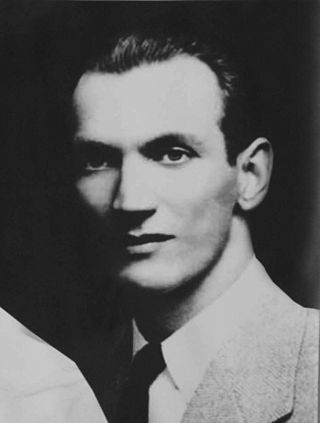
Jan Karski was a Polish soldier, resistance-fighter, and diplomat during World War II. He is known for having acted as a courier in 1940–1943 to the Polish government-in-exile and to Poland's Western Allies about the situation in German-occupied Poland. He reported about the state of Poland, its many competing resistance factions, and also about Germany's destruction of the Warsaw Ghetto and its operation of extermination camps on Polish soil that were murdering Jews, Poles, and others.

The Archdiocese of Washington is a Latin Church ecclesiastical territory, or archdiocese, of the Catholic Church for the District of Columbia and several Maryland counties in the United States.

Mount Olivet Cemetery is a 206-acre (83 ha) cemetery located in Nashville, Tennessee. It is located approximately two miles East of downtown Nashville, and adjacent to the Catholic Calvary Cemetery. It is open to the public during daylight hours.
William Duhurst Merrick was a United States Senator from Maryland, serving from 1838 to 1845.

Mount Olivet Cemetery is a Roman Catholic cemetery located in Chicago, Illinois. The cemetery is operated by the Archdiocese of Chicago. The cemetery is located at 2755 West 111th Street.
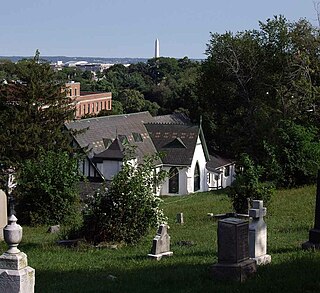
Holy Rood Cemetery is located at 2126 Wisconsin Avenue N.W. at the southern end of Glover Park, adjacent to Georgetown in Washington, D.C. It is at one of the highest elevations in the city and has memorable views. The cemetery contains approximately 7,000 burials, including as many as 1,000 free and enslaved African Americans. It may be the best-documented slave burial ground in the District of Columbia.
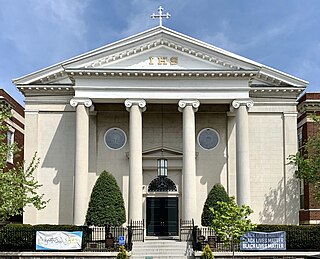
Holy Trinity Catholic Church is a Catholic church run by the Jesuit order that is located in the Georgetown neighborhood of Washington, D.C., in the United States. Holy Trinity Parish was founded in 1787 and is the oldest Roman Catholic community and house of worship in continuous operation both in Georgetown and in the larger city of Washington, D.C. The original church building was completed in 1794. It is now called the Chapel of St. Ignatius, and is used for smaller ecclesiastical celebrations and as an auxiliary space for parish activities. A larger church building, necessitated by the growing community, was dedicated in 1851, and still serves as the parish church today.
Mount Olivet Cemetery is a cemetery at 17100 Van Dyke Avenue in the city of Detroit in Wayne County, Michigan. It is owned and operated by the Mt. Elliott Cemetery Association, a not-for-profit Catholic organization that is otherwise administered independently from the Roman Catholic Archdiocese of Detroit and any of the various Catholic religious orders active in Metro Detroit. At 320 acres (130 ha), it is the largest cemetery in Detroit, although it no longer promotes itself publicly as a Catholic establishment.
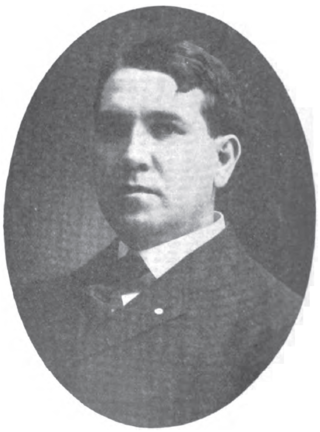
Timothy Thomas Ansberry was a U.S. Representative from Ohio.

Ralph Hunter Daughton was an American lawyer and politician who served as a U.S. Representative from Virginia from 1944 to 1947.
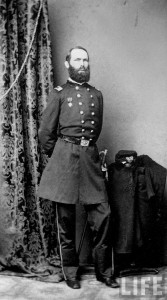
Julius Peter Garesché, birth name "Julio Pedro Garesché de Rocher", was an American professional soldier. He was killed at the Battle of Stones River, Tennessee during the American Civil War. The Union Army's Battery Garesché was named for him.

Mount Zion Cemetery/Female Union Band Society Cemetery is a historic cemetery located at 27th Street NW and Mill Road NW in the Georgetown neighborhood of Washington, D.C., in the United States. The cemetery is actually two adjoining burial grounds: the Mount Zion Cemetery and Female Union Band Society Cemetery. Together these cemeteries occupy approximately three and a half acres of land. The property fronts Mill Road NW and overlooks Rock Creek Park to the rear. Mount Zion Cemetery, positioned to the East, is approximately 67,300 square feet in area; the Female Union Band Cemetery, situated to the West, contains approximately 66,500 square feet. Mount Zion Cemetery, founded in 1808 as The Old Methodist Burial Ground, was leased property later sold to Mount Zion United Methodist Church. Although the cemetery buried both White and Black persons since its inception, it served an almost exclusively African American population after 1849. In 1842, the Female Union Band Society purchased the western lot to establish a secular burying ground for African Americans. Both cemeteries were abandoned by 1950.
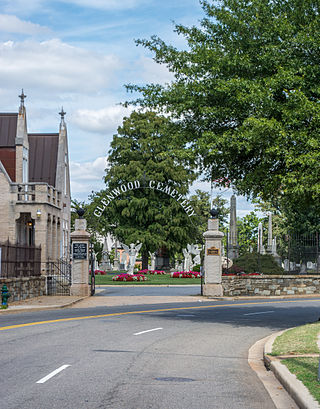
Glenwood Cemetery is a historic cemetery located at 2219 Lincoln Road NE in Washington, D.C. It is a private, secular cemetery owned and operated by The Glenwood Cemetery, Inc. Many famous people are buried in Glenwood Cemetery, and the cemetery is noted for its numerous elaborate Victorian and Art Nouveau funerary monuments. The cemetery was listed on the National Register of Historic Places in 2017; its mortuary chapel was separately listed in 1989.
Columbian Harmony Cemetery was an African-American cemetery that formerly existed at 9th Street NE and Rhode Island Avenue NE in Washington, D.C., in the United States. Constructed in 1859, it was the successor to the smaller Harmoneon Cemetery in downtown Washington. All graves in the cemetery were moved to National Harmony Memorial Park in Landover, Maryland, in 1959. The cemetery site was sold to developers, and a portion used for the Rhode Island Avenue – Brentwood Washington Metro station.

The Presbyterian Burying Ground, also known as the Old Presbyterian Burying Ground, was a historic cemetery which existed between 1802 and 1909 in the Georgetown neighborhood of Washington, D.C., in the United States. It was one of the most prominent cemeteries in the city until the 1860s. Burials there tapered significantly after Oak Hill Cemetery was founded nearby in 1848. The Presbyterian Burying Ground closed to new burials in 1887, and about 500 to 700 bodies were disinterred after 1891 when an attempt was made to demolish the cemetery and use the land for housing. The remaining graves fell into extensive disrepair. After a decade of effort, the District of Columbia purchased the cemetery in 1909 and built Volta Park there, leaving nearly 2,000 bodies buried at the site. Occasional human remains and tombstones have been discovered at the park since its construction. A number of figures important in the early history of Georgetown and Washington, D.C., military figures, politicians, merchants, and others were buried at Presbyterian Burying Ground.
Holmead's Burying Ground, also known as Holmead's Cemetery and the Western Burial Ground, was a historic 2.94-acre (11,900 m2) cemetery located in the Dupont Circle neighborhood of Washington, D.C., in the United States. It was founded by Anthony Holmead in 1794 as a privately owned secular cemetery open to the public. The city of Washington, D.C., constructed the Western Burial Ground on the remainder of the city block in 1798, and the two burial grounds became synonymous. The city took ownership of the private Holmead cemetery in 1820. The unified cemetery went into steep decline around 1850, and it was closed on March 6, 1874. Removal of remains, most of which were reinterred at Graceland Cemetery or Rock Creek Cemetery, continued until 1885.
Payne's Cemetery was a 13-acre (53,000 m2) cemetery located in the Benning Ridge neighborhood of Washington, D.C., in the United States. It was founded in 1851 as a privately owned secular cemetery open to the public, but it primarily served the city's African American community. The cemetery was declared abandoned by the city in 1966. About 2,000 bodies at Payne's Cemetery were reinterred at National Harmony Memorial Park cemetery in Prince George's County, Maryland. Two public schools and a recreation center were constructed atop the cemetery in the late 1960s, during which time hundreds of corpses were unearthed and summarily disposed of.
Francisco Xavier de la Paz Pizarro Martínez was a Mexican diplomat who served as Envoy Extraordinary and Minister Plenipotentiary of Mexico to the United States from 17 October 1837 until his death on 9 February 1840. Previously, Pizarro served as Mexican consul to New Orleans.

The Basilica of Saint Mary in the Old Town Old and Historic District, of Alexandria, Virginia, and is a minor basilica and parish church of the Roman Catholic Diocese of Arlington in Virginia. The Basilica of Saint Mary is the oldest Roman Catholic church in the Commonwealth of Virginia. It was founded in 1795 by the Very Reverend Francis Ignatius Neale, then the president of Georgetown University, in present-day western Washington, D.C.

















